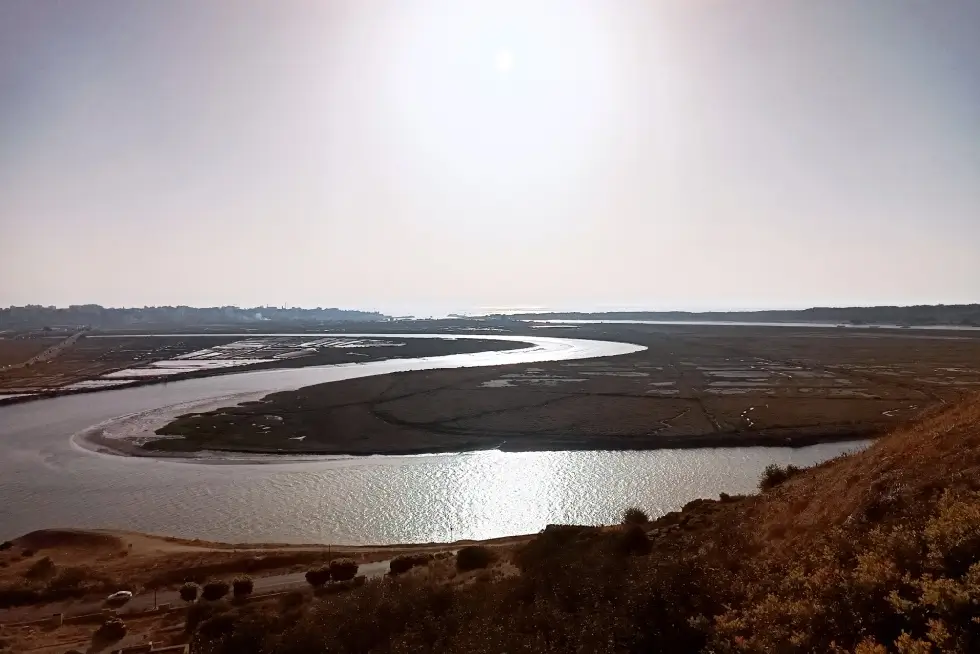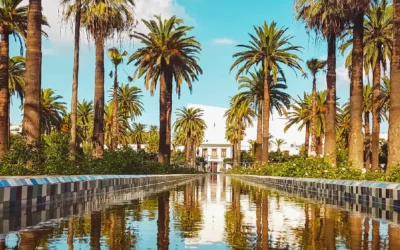Larache: The City Of Morocco Where the River Meets the Sea

Table of Contents:
Introduction to Larache City
Larache, also known as Al-ʿArāʾīsh in Arabic, stands as a stunning port city on Morocco’s northern Atlantic coast, where the Loukkos River flows into the ocean. This city is a gem in the Tanger–Tetouan–Al Hoceima region of Morocco.
Just a 90-minute drive from the Strait of Gibraltar, Larache is an ideal day trip spot from Tangier.
Nearby, the ancient Roman city of Lixus, once a bustling harbor, tells a tale of change and adaptation as it was abandoned due to the silting of the Oued Loukos estuary.
Established as part of the Tangiers-Tetouan administrative region in 1985, Larache now boasts a population of around 125,008 people.
Famous for its westward-facing Atlantic beaches, the city offers a spectacular coastal experience under the warm, shining sun.
Larache Discovery Tour
Larache, a charming city in Morocco, offers a variety of popular attractions for visitors to explore:
1. Lixus Ruins: A Window to the Past
Step back in time at the Lixus Ruins, a captivating archaeological site revealing Larache’s history from the Phoenician era. This ancient marvel offers a unique peek into the city’s storied past.
2. Medina: The Pulse of Larache
Immerse yourself in the vibrant heart of Larache, the Medina. This bustling area is a tapestry of traditional markets and rich cultural experiences, showcasing the city’s dynamic spirit.
3. Place de la Libération: The City’s Social Hub
Experience the lively atmosphere at Place de la Libération, a focal point for both historical significance and social gatherings in Larache. This lively spot is a must-visit for its energetic vibe.
4. Ras El Raml Beach: A Coastal Escape
Relax and soak in the scenic beauty at Ras El Raml Beach. This gorgeous beach is ideal for unwinding and is the perfect spot to enjoy Larache’s stunning coastal views.
5. The Little Market: A Shopper’s Delight
Discover the charm of The Little Market, a local marketplace brimming with various goods. From daily necessities to unique treasures, this market has something for everyone.
6. Bab Barra Gate: Gateway to Tradition
Enter the historical Medina through the Bab Barra Gate. This gate leads you to the characteristic souk, a bustling market filled with everything from antiques to exquisite leather goods.
7. Nasaria Mosque and Church of St. Joseph: Symbols of Harmony
Explore the Jewish Quarter’s Nasaria Mosque and Church of St. Joseph. These landmarks are emblematic of Larache’s diverse cultural and religious tapestry.
8. Spanish Cemetery: A Poet’s Final Resting Place
Visit the serene Spanish Cemetery, the chosen burial site of a Spanish poet who cherished Larache. Open mainly in the mornings and afternoons, this historic site offers a peaceful retreat.
9. Explore More: Tours and Activities
Larache is a city of exploration, offering various tours and activities. From historical to cultural and walking tours, these experiences provide an in-depth discovery of the region’s rich heritage and beauty.
Larache Accessibility And Transportation
A. Exploring Larache: Your Gateway to Travel
1. The Heart of Movement: Larache’s Bus Station
Central to the city’s transport network is the Larache bus station, located on Station Road. It serves as more than just a transit point; it’s a gateway linking Larache with key destinations. Hosting two major bus companies, Compagnie De Transports Au Maroc and ALSA, this station offers travelers regular services to locations such as Casablanca, Tangier, and even Madrid.
2. Connectivity at Its Best
Close to the main bus hub are other stations, such as Gare routière CTM de Larache, which further improve accessibility. Popular routes from these stations reach cities like Rabat, Fes, Barcelona, and Málaga, demonstrating Larache’s extensive connectivity within and outside Morocco.
B. Ease of Travel: Options Galore
1. By Bus: The Convenient Choice
Choosing to travel by bus is a smart option for those without their own transport. The journey from Larache to Casablanca, for instance, is not only cost-effective (ranging from MAD 100 to MAD 160) but also swift, taking approximately 3 hours and 46 minutes. CTM buses offer frequent and comfortable services, departing directly from Larache station for this route.
2. By Car: The Speedy Alternative
For those who favor speed, driving presents a quicker but more expensive alternative. Spanning 263 km in about 2 hours and 37 minutes, it suits travelers seeking a more private journey, though it comes at a greater expense, ranging from 410 MAD to 600 MAD.
C. Return Journey: Casablanca to Larache
1. Seamless Return Trips
CTM doesn’t just get you out of Larache; it brings you back too. Buses from Casablanca to Larache are equally efficient, mirroring the cost and duration of the outward journey. These buses run twice daily, ensuring that you can always find a ride back to Larache without hassle.
Modern Larache and its Economic Significance
1. Diverse Economic Foundations
Larache stands out in northern Morocco for its dynamic economy, rooted in agriculture, fishing, and manufacturing. The city’s port is a bustling hub, exporting essentials like produce, timber, and wool.
2. Energy Sector Breakthrough
Recently, Larache leaped forward with the discovery of significant gas reserves offshore, thanks to the efforts of Repsol and Chariot Oil and Gas. This positions Larache at the forefront of Morocco’s energy sector.
3. Agricultural Innovation
The city also shines in sustainable agriculture. Frulact, a leader in fruit preparations, collaborates with local farmers, turning Larache’s strawberries into high-value products for both domestic and international markets.
These aspects vividly showcase Larache’s evolving and influential role in Morocco’s economy.
Larache History Overview
Ancient Beginnings: The Lixus Connection
Larache’s story starts in the 12th century BCE with Lixus, an influential Berber and Phoenician hub. These ancient ruins, a mere two miles from modern Larache, signal the city’s longstanding significance.
Phoenician and Carthaginian Era
In the 7th century BCE, Lixus entered a new chapter under Phoenician settlement, later coming under Carthaginian rule. This era shaped Larache’s early cultural and political landscape.
A Haven for Crypto-Jews
The 16th century saw a unique demographic shift. Following Portugal’s 1542 expulsion of Jews, many crypto-Jews found refuge in Larache, enriching its social fabric.
Spanish Influence
Spanish rule, spanning from 1610 to 1689 and again from 1912 to 1956, left a lasting architectural mark. Larache’s terraced old city and the prominent Kebibat fortress are testaments to this period.
Larache, a blend of Berber, Phoenician, Jewish, and Spanish influences, stands as a vibrant testament to Morocco’s diverse historical tapestry.
Conclusion
Larache’s rich cultural heritage, with its breathtaking coastal scenery and historical importance, marks it as a must-visit for anyone interested in Morocco’s history and the splendor of its Atlantic coastline.
FAQ
How far is Larache from the Strait of Gibraltar?
Larache is about a 90-minute drive from the Strait of Gibraltar, making it an ideal day trip spot from Tangier.
How accessible is Larache by public transport?
Larache is well-connected by bus with major destinations like Casablanca, Tangier, and Madrid. The main bus station, along with other stations like Gare routière CTM de Larache, facilitates this connectivity.
Where is Larache City located?
Larache is a port city on Morocco’s northern Atlantic coast, where the Loukkos River flows into the ocean. It is part of the Tanger-Tetouan-Al Hoceima region of Morocco.
What is the significance of the nearby ancient Roman city of Lixus?
Lixus, once a bustling harbor near Larache, showcases the city’s historical significance. Its abandonment due to the silting of the Oued Loukos estuary tells a tale of change and adaptation.
What is the population of Larache?
As of the latest information, Larache has a population of around 125,008 people.
What attractions are popular in Larache?
Larache offers attractions like the Lixus Ruins, the vibrant Medina, Place de la Libération, Ras El Raml Beach, The Little Market, Bab Barra Gate, Nasaria Mosque, the Church of St. Joseph, and the Spanish Cemetery.
What are the travel options within Larache?
Travelers can choose buses for cost-effective travel or opt for driving for a quicker, though more expensive, journey.
What economic activities are prominent in Larache?
Larache’s economy is diverse, with agriculture, fishing, and manufacturing being key sectors. The discovery of gas reserves and innovations in sustainable agriculture, like Frulact’s collaboration with local farmers, are notable economic developments.
Can you give a brief overview of Larache’s history?
Larache’s history dates back to the 12th century BCE with Lixus. It has been influenced by various cultures including Berber, Phoenician, Jewish, and Spanish, each leaving its mark on the city’s cultural and architectural landscape.



